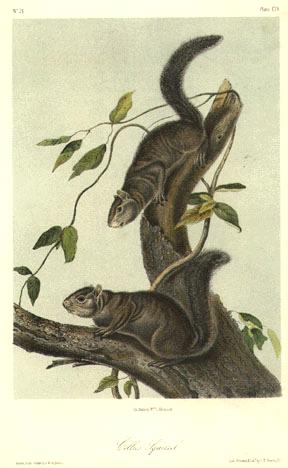

104 Collie's Squirrel
SCIURUS COLLIAEI.--RICH.
[Sciurus griseus]
COLLIE'S SQUIRREL
[Western Gray Squirrel]
PLATE CIV.--MALES.
S. Supra e fresco-nigro flavoque varius subtus ex flavescente albidus;
magnitudine S. migratorii.
CHARACTERS.
Size of Sciurus Migratorius; upper parts mottled brownish black and yellow;
under surface cream white.
SYNONYMES.
SCIURUS COLLIAEI. Richardson, Append. to Beechey's Voyage.
SCIURUS COLLIAEI. Bachman, Proc. Zool. Soc. 1838 (Monog. of
Genus Sciurus).
DESCRIPTION.
In size and form this species bears some resemblance to the migratory gray
Squirrel of the middle or northern States; the tail, however, in the only
specimen which exists in any collection, appears much smaller and less
distichous, and the animal, when other specimens are examined, may prove to be
intermediate in size between the Carolina gray Squirrel and S. Migratorius.
The fur is rather coarse, and the tail appears to be somewhat cylindrical;
ears, of moderate size, ovate, clothed with short hairs on both surfaces, but
not tufted.
COLOUR.
Above, grizzled with black and dull-yellow; sides of the muzzle, under
parts of the body, and inner sides of limbs, dull-white; tail, moderate, the
hairs grayish-white, three times annulated with black. Hairs of the body, both
above and beneath, grey at the roots, those on the back having lengthened black
tips broadly annulated with dull-yellow. The hairs of the head resemble those
of the back, except on the front, where they are annulated with dull-white; top
of the muzzle, brown; cheeks, greyish; insides of ears, yellowish, indistinctly
freckled with brown; outsides, grizzled with black and yellow on the forepart,
but posteriorly covered with long whitish hairs; hairs on the feet, black at the
roots, white at the tips, the feet and legs being dirty cream-colour, pencilled
with dusky; whiskers, long as the head, composed of bristly black hairs. The
above description was taken by us from the specimen in the Zoological Society's
Museum, London; the skin was not in very good condition, and a portion of the
tail was wanting.
DIMENSIONS.
Inches. Lines.
Length from nose to root of tail, . . 0 9
Length of tail to end of hair, . . . 9 6
Height of ear posteriorly, . . . . 0 6
Tarsus (including nail), . . . . . 2 5
Nose to ear, . . . . . . . . . 2 0
HABITS.
Our figures of this Squirrel were made from the specimen presented to the
Zoological Society of London by Captain BEECHEY; the original from which the
species was described and named by our friend Dr. RICHARDSON.
All the information we have as to the habits of this animal is contained in
the above-mentioned appendix (p. 8): "Mr. COLLIE observed this Squirrel, in
considerable numbers, sporting on trees at San Blas in California (?), where its
vernacular name signifies 'Little Fox-Squirrel.' It feeds on fruits of various
kinds. Although unwilling to incur the risk of adding to the number of
synonymes with which the history of this large genus is already overburdened, I
do not feel justified in referring it to any of the species admitted into recent
systematic works; and I have therefore described it as new, naming it in
compliment to the able and indefatigable naturalist who procured the specimen."
GEOGRAPHICAL DISTRIBUTION.
This species was given by RICHARDSON, as appears by the above quotation,
as existing at San Blas, California; this place, however, if we have not
mistaken the locality, is in the district of Xalisco in Mexico, and within the
tropics; it is doubtful, therefore, whether the species will be found to inhabit
any portion of California. J. W. AUDUBON did not observe it in his travels
through Upper California.
GENERAL REMARKS.
This species is very nearly allied to Sciurus Aureogaster of F. CUVIER, and
it is yet possible that it may prove a variety of that very variable species, in
which the under parts of the body are sometimes white, instead of the usual
deep-red colour.
A specimen of S. Aureogaster in the Museum at Paris has the under parts of
the body white, with small patches of red, and with a few scattered red hairs
here and there mingled with the white ones.
|